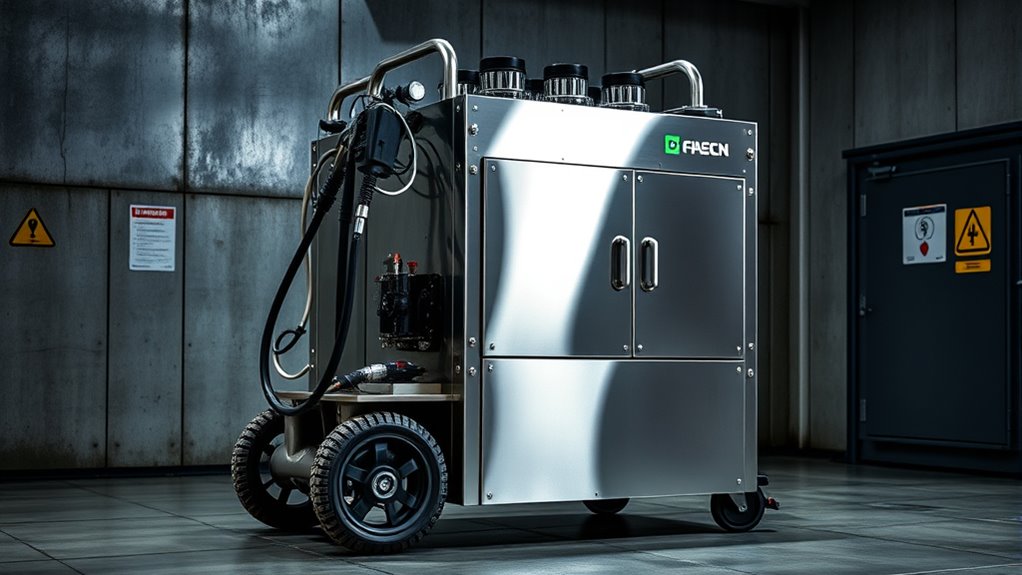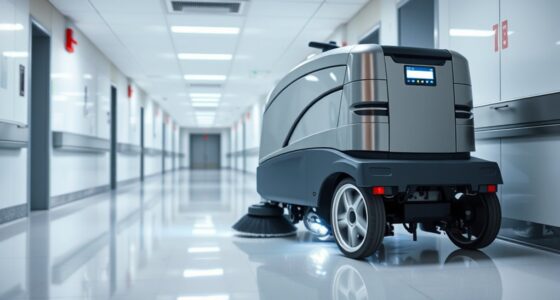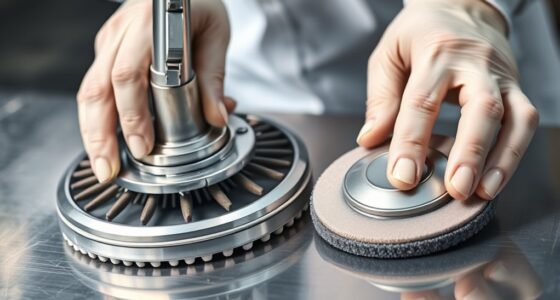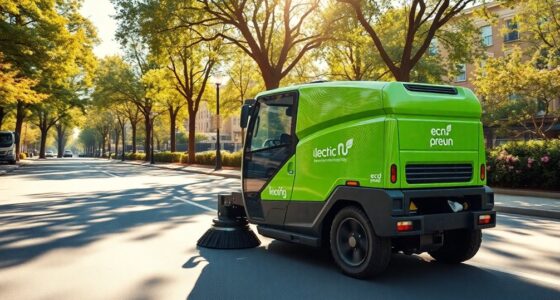ATEX/explosion-proof cleaning machines are built to keep you safe in environments with flammable gases or dust. They prevent ignition sources by using sealed components, spark-resistant materials, and explosion-proof enclosures. Designed to contain dust and static, these machines help you meet safety standards and avoid costly accidents. Proper equipment guarantees effective cleaning without risking explosions. If you want to understand how these features work together to protect you and your facility, keep exploring further.
Key Takeaways
- ATEX/Explosion-proof cleaning machines are designed to prevent ignition sources in hazardous environments with flammable gases or dust.
- These machines feature dust mitigation systems and sealed components to reduce dust accumulation and dispersal during cleaning.
- Certification such as ATEX ensures compliance with safety standards and rigorous testing for explosive atmospheres.
- Construction includes explosion-proof enclosures, spark-resistant materials, and grounding systems to minimize explosion risks.
- Proper selection ensures safety compliance, protects personnel and assets, and enables effective cleaning in hazardous areas.
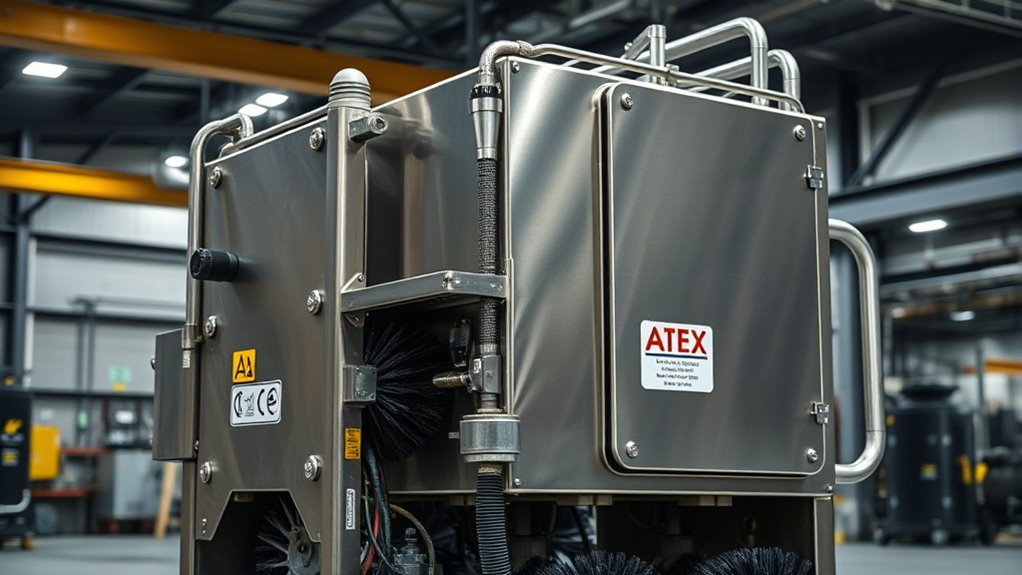
If your cleaning operations take place in environments with flammable gases or dust, using ATEX or explosion-proof cleaning machines isn’t just recommended—it’s indispensable. These specialized machines are designed to prevent ignition sources that could trigger explosions, making them pivotal for maintaining safety standards in hazardous areas. When selecting equipment for such environments, dust mitigation becomes a top priority. Dust particles, even when seemingly harmless, can accumulate and pose a significant explosion risk if they become airborne and ignite. Explosion-proof cleaning machines are engineered to contain dust and prevent it from dispersing into the environment, reducing the chance of ignition and guaranteeing safer operations. Additionally, dust mitigation features are integral to these machines, actively reducing dust accumulation and dispersal during cleaning processes. Safety certifications play an essential role in verifying that these machines meet strict industry standards. Certifications such as ATEX (ATmosphères EXplosibles) indicate compliance with European Union directives that specify the safety requirements for equipment used in explosive atmospheres. These certifications give you confidence that the cleaning machines have undergone rigorous testing and adhere to necessary safety protocols. Without proper safety certifications, you risk using equipment that may not be adequately protected against sparks, static, or heat, which could lead to catastrophic failures in hazardous environments. Explosion-proof cleaning machines are built with durable, intrinsically safe components. They incorporate features like sealed motors, spark-resistant materials, and explosion-proof enclosures to contain any sparks or heat that might originate during operation. This design minimizes the risk of igniting dust clouds or flammable gases. Additionally, these machines often include grounding and static dissipation systems to prevent static buildup, which could otherwise serve as an ignition source. Such features are essential for effective dust mitigation, ensuring that dust doesn’t accumulate on or inside the equipment, which could compromise safety over time. Investing in the right equipment means paying attention to both the technical specifications and the safety certifications. Properly certified explosion-proof cleaning machines help you stay compliant with health and safety regulations, avoid costly shutdowns, and protect your personnel. They enable you to perform thorough cleaning without risking an explosion, even in the most challenging environments. By prioritizing dust mitigation and choosing machines with recognized safety certifications, you guarantee that your cleaning operations are both efficient and safe, safeguarding your facility, staff, and assets from avoidable hazards.
Frequently Asked Questions
How Do Explosion-Proof Cleaners Differ From Standard Cleaning Machines?
Explosion-proof cleaners differ from standard machines by featuring enhanced dust filtration and motor safety measures. You’ll find these machines designed to prevent sparks and limit ignition risks in hazardous environments. They use specialized enclosures and grounding techniques to contain any sparks or explosions. This guarantees you can clean safely without risking ignition sources, especially in areas with flammable dust or vapors, providing peace of mind during demanding cleaning tasks.
What Certifications Are Required for Atex/Explosion-Proof Cleaning Equipment?
You need ATEX and IECEx certifications for explosion-proof cleaning equipment, guaranteeing spark protection and electrical safety. These certifications verify the equipment meets strict international standards for hazardous environments. About 80% of industries in hazardous zones rely on certified tools to prevent explosions. By choosing equipment with these certifications, you ensure safety and compliance, reducing the risk of accidents caused by electrical sparks or unsafe components in explosive atmospheres.
Can These Machines Be Used in Wet and Dry Environments Simultaneously?
Yes, these machines can often be used in both wet and dry environments simultaneously, thanks to their moisture resistance and multi-environment compatibility. You can depend on them to handle wet cleanup tasks without risking electrical issues, while still functioning effectively in dry conditions. Their design guarantees safety and durability across diverse environments, making them versatile tools for various industrial cleaning needs. Just confirm the specific model meets your operational requirements.
What Maintenance Is Necessary to Ensure Explosion-Proof Integrity?
Did you know that proper maintenance can extend explosion-proof machinery lifespan by up to 30%? To guarantee explosion-proof integrity, you need regular inspection protocols and attention to protective coatings. Check electrical components, seals, and wiring frequently for wear or damage. Reapply protective coatings as needed to prevent corrosion and contamination. Staying vigilant with routine maintenance helps you keep the machines safe, reliable, and compliant with safety standards.
Are There Specific Training Requirements for Operators of Explosion-Proof Cleaners?
Yes, you need specific training for operating explosion-proof cleaners. You should complete safety protocols training and obtain operator certification to guarantee you’re qualified. This training covers proper handling, safety checks, and emergency procedures, helping you prevent accidents and maintain the equipment’s explosion-proof integrity. Always stay updated on safety standards and follow manufacturer instructions to keep yourself and your environment safe while using these specialized cleaning machines.
Conclusion
Ultimately, selecting the appropriate ATEX or explosion-proof cleaning apparatus guarantees safety, efficiency, and excellence. By understanding your environment and equipment needs, you can confidently avoid accidents and abrasive atmospheres. Remember, safety starts with smart selection, steadfast standards, and solid support. So, step confidently into safer cleaning solutions, safeguarding your space, staff, and success. Stay secure, stay sustainable, and streamline your cleaning with the right explosion-proof machinery today!
